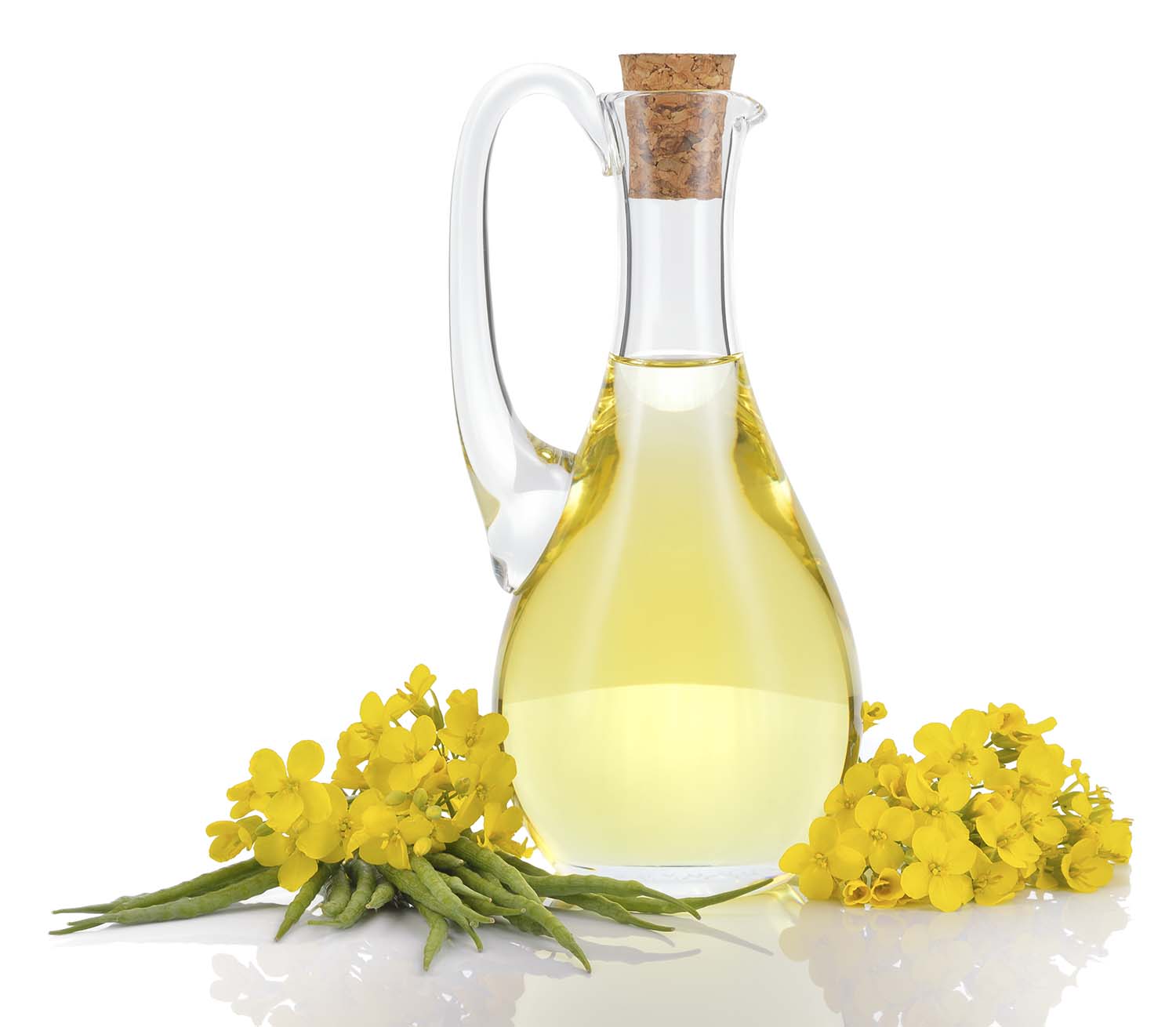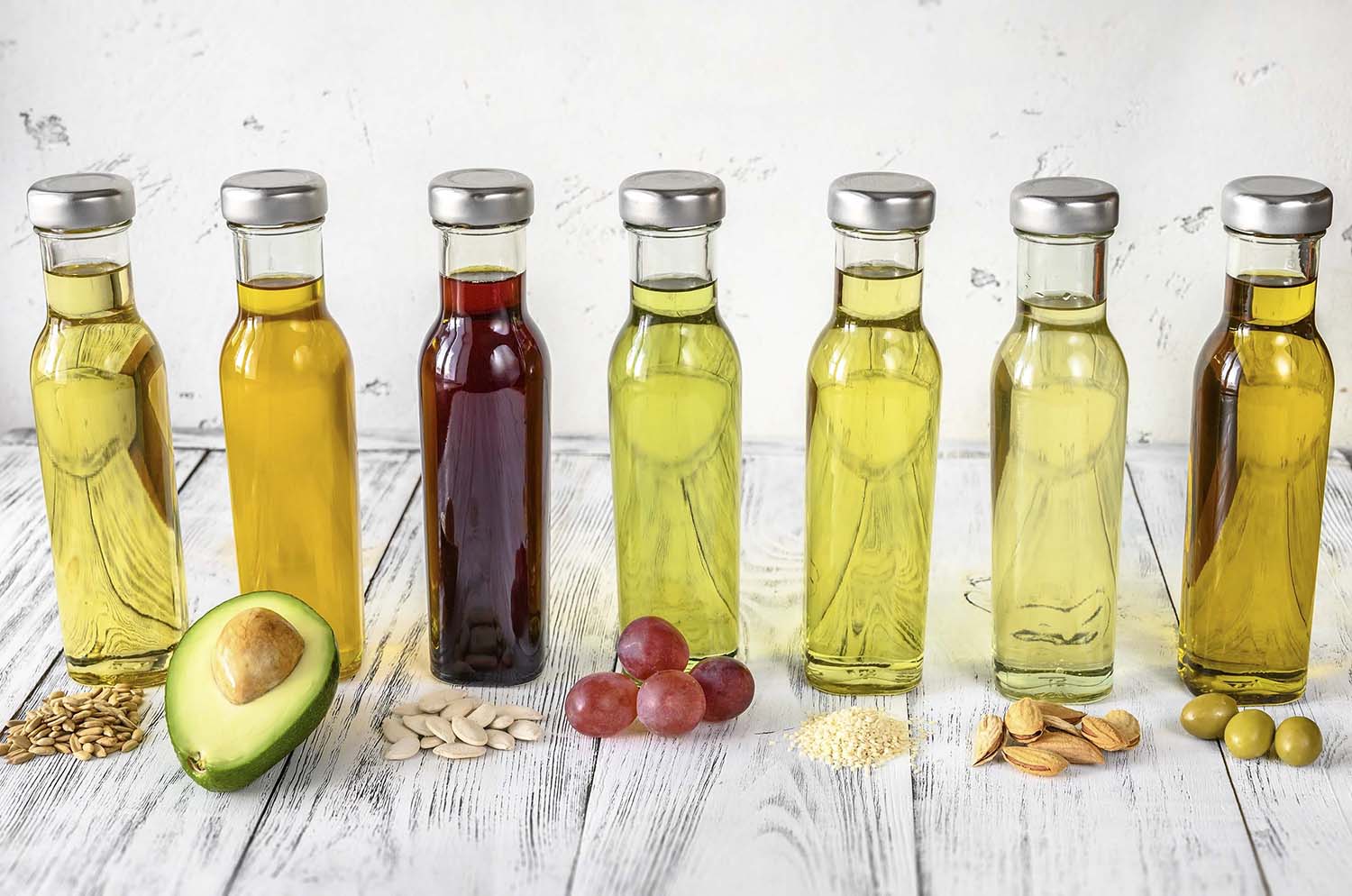Properties of High Oleic Seed Oils
Vegetable oils, such as canola, sunflower and soybean oils, are composed of mainly triacylglycerides (TAG) consisting of three fatty acids attached to a glycerol backbone (see fact sheet FAPC-196 Lipid Glossary). Fatty acid composition of oils determine their physical, chemical and nutritional properties. Unsaturated fatty acids having one or more double bonds on the carbon chain are considered healthier than saturated fatty acids (no double bond). Although unsaturated fatty acids are good for health, their oxidative and thermal stability is lower than that of the saturated fatty acids. Stability of fatty acids decreases as the number of double bonds increases on the molecule. For example, the ratios of the rates of oxidation of oleic acid (one double bond): linoleic acid (two double bonds): linolenic acid (three double bonds) have been reported as 1:10:20, meaning that linoleic and linolenic acids oxidize 10 and 20 times faster than the oleic acid, respectively. Off-flavors and harmful chemical compounds are formed during oil oxidation and degradation. Hence, an oxidized oil with highly unsaturated fatty acid content can be more harmful to human health than a good quality saturated fat or oil (see fact sheet FAPC-197 Edible Oil Quality).
Advancements in biotechnology allowed plant scientists to modify fatty acid composition of oilseeds and develop products suitable for diverse food and nonfood applications for decades. The ultimate goal is to balance oil stability, functionality and nutritional characteristics of the oils. Functionality of the oil to be used in a given application is as important as its stability and health profile. For example, although unsaturated liquid oils are healthy, they do not provide the solid content required for desirable texture in baking applications.
Traditional breeding, mutagenesis and transgenesis have been successfully used to modify fatty acid composition of various oilseeds. Today, high oleic, palmitic, linolenic, stearic, low linolenic acid soybean, canola, safflower and sunflower seed oils are commercially available.
Seed oils containing high amounts of oleic acid, also referred to as high oleic (HO) oils, are gaining attention because of their desirable fatty acid composition that provides higher oxidative and thermal stability and healthier nutritional profile. The Food and Agriculture Organization of the United Nations' (FAO) nutritional guidelines recommend high amount of oleic acid intake for a healthy diet. These oils make excellent ingredients for food formulation, particularly for industrial frying applications, because they are both stable and have a healthy nutritional profile.
Table 1 summarizes fatty acid composition of commercially available HO oils and respective conventional oils.
Table 1: Fatty acid composition (percent of total fatty acids) of various conventional and high oleic oils (CON-CAN: conventional canola, HO-CAN: high oleic canola, NUSUN: mid oleic sunflower, HO-SAFF: high oleic safflower, CON-SOY: conventional soybean and HO-SOYBEAN: high oleic soybean).
|
Fatty Acid Name |
CON-CAN | HO-CAN | NUSUN | HO-SUN | CON-SOY | HO-SOY |
|---|---|---|---|---|---|---|
|
Palmitic Acid (C16:0) |
4.0 | 4.0 | 5.0 | 4.0 | 11.0 | 7.0 |
|
Palmitoleic Acid (C16:1) |
0.2 | 0.2 | 0.1 | 0.1 | 0.2 | - |
|
Stearic Acid (C18:0) |
2.0 | 2.0 | 4.0 | 4.0 | 4.0 | 3.0 |
| Oleic Acid (C18:1) | 64.0 | 76.0 | 61.0 | 84.0 | 23.0 | 85.0 |
| Linoleic Acid (C18:2) | 19.0 | 14.0 | 29.0 | 6.0 | 54.0 | 1.0 |
| Arachidic Acid (C20:0) | 0.6 | 0.7 | 0.3 | 0.3 | 0.5 | 0.4 |
| Eicosenoic Acid (C20:1) | 2.0 | 1.0 | 0.2 | 0.3 | 0.3 | - |
| Linolenic Acid (C18:3) | 8.0 | 2.0 | 0.1 | 0.1 | 8.0 | 2.0 |
| Behenic Acid (C22:0) | 0.3 | 0.3 | 0.9 | 1.0 | 0.5 | 0.4 |
|
Lignoceric Acid (C24:0) |
0.2 | 0.2 | 0.3 | 0.4 | 0.4 | - |
|
Saturated |
6.9 | 7.2 | 10.5 | 9.7 | 16.4 | 10.8 |
|
Unsaturated |
93.2 | 93.0 | 90.4 | 90.5 | 85.5 | 88.0 |
|
Monounsaturated |
66.2 | 77.2 | 61.3 | 84.1 | 23.5 | 85.0 |
|
Polyunsaturated |
27.0 | 16.0 | 29.1 | 6.1 | 62.0 | 3.0 |
In general, HO oils are characterized by their 70% or more oleic acid content. Today, oils from various oilseeds with about 90% oleic acid content, such as sunflower seeds, are available. It is important to note fatty acid percentages shown in Table 1 represent typical compositions rather than absolute values. Fatty acid composition of the seeds are affected not only by the variety or cultivar but also by the agronomic practices used and the climate in which plants are grown. Hence, oil composition may vary slightly even within the same variety/cultivar, depending on the growth conditions.
Some of the vegetable oils, such as olive and canola oils, are naturally rich in oleic acid. Conventional or regular canola oil naturally contains about 60% oleic acid, which was increased to more than 75% through biotechnology in the modified HO canola seeds.
Regular or conventional sunflower seed oil is a linoleic acid rich oil containing virtually no linolenic, about 20% oleic, 6% palmitic acid and 5% stearic acid. Sunflower seed oil is widely used for cooking, specifically for frying because of its bland flavor, light color and good stability. NuSun is the mid-oleic sunflower oil, which contains lower saturated fatty acids (less than 10%) and higher oleic acid (55-75%) than the regular sunflower oil. Linoleic acid content of NuSun is 15-35%. HO oils containing more than 80% oleic acid obtained from modified seeds further enhanced the value of sunflower seed oil for the food industry. Modified sunflower seeds were obtained via breeding, not genetic engineering.
Conventional soybean oil has been the oil of choice for the food industry in the U.S. because of its broad availability and relatively lower price than other commodity oils. However, oxidative and thermal stability of conventional soybean oil is quite poor because of the high concentration of polyunsaturated fatty acids (more than 50% linoleic and 7% linolenic acids) present in the oil. In HO soybean oil, both linoleic and linolenic acid concentrations are lowered by increasing oleic acid content. Since oleic acid is a monounsaturated fatty acid, increasing its concentration while reducing polyunsaturated fatty acid content in the oil enhanced relative stability of HO soybean oil making it more competitive with the other oils, such as conventional sunflower, cottonseed and canola oils.
Physical properties of the oils are important factors affecting their functionality. Specific gravity of the HO oils are slightly lower than their conventional counterparts. For example, specific gravity of CON-SUN and HO-SUN at 20 degrees Celsius are 0.918-0.923 and 0.915-0.920. HO oils have higher refractive index than the traditional cultivars, i.e. refractive index of CON-SUN and HO-SUN are 1.472-1.469 and 1.467-1.469 at 25 degrees Celsius, respectively.
In general, large oilseed handling and processing companies do not segregate seeds by variety/cultivar. Seeds are usually marketed according to a grading system that evaluates oil, chlorophyll and moisture contents, percent of damaged seeds, impurities (other seeds, stones, insects etc.), free fatty acids, appearance, smell and seed size. Segregation of HO seeds from their conventional counterpart requires changes in the harvesting, storage and distribution infrastructure already in place for commodity seeds and increases the final product cost. Due to the inadequate production, availability of HO oils is still limited.
Conclusions
HO seed oils contain 70% (percent of total fatty acids in the oil) or higher oleic acid.
Currently, seed oils containing about 90% oleic acid are available, i.e. high oleic sunflower oil.
An increase in the oleic acid content of oils at the expense of polyunsaturated fatty acids, including linoleic and linolenic acids improve their thermal and oxidative stability.
Although HO oils are more stable than their conventional counterparts, they might not provide some of the functionality needed in specific applications, i.e. solid content needed for good texture in baked goods.
Even though fatty acid composition of an oil significantly affects its stability, initial oil quality and some of the minor components naturally present in vegetable oils (i.e. tocopherols) also impact their shelf life and oxidative and thermal stability.


